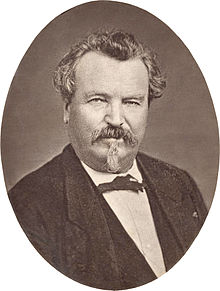Loading AI tools
French architect, photographer and scientific writer (1818–1895) From Wikipedia, the free encyclopedia
Pierre Trémaux (20 July 1818 – 12 March 1895) was a French architect, Orientalist photographer and author of numerous scientific and ethnographic publications.
Pierre Trémaux | |
|---|---|
 Portrait of Pierre Trémaux, 1866 | |
| Born | 20 July 1818 Charrecey, France |
| Died | 12 March 1895 (aged 76) Tournus, France |
| Nationality | French |
| Education | École des Beaux-Arts |
| Known for | architect, illustrator, author and photographer |
| Movement | Orientalist |
| Awards | Chevalier, Légion of Honour; Prix de Rome |
Very little is known about Pierre Trémaux's life. He was born in Charrecey, France, into a family of modest means. He was the son of Jean-Marie Trémaux, a farmer and Claudine Renaudin, and had at least two sisters. Details of his final years are very sketchy and no details of his death and final resting place are known.[1]
Trémaux distinguished himself in many fields. He entered the École des Beaux-Arts in 1840 and received the second Prix de Rome in Architecture in 1845. As a trained architect, he worked at the Schneider establishments in Le Creusot. He was interested in urbanism and the construction of the Suez Canal in Egypt.
Interested in natural history, he traveled to Algeria, Tunisia, Upper Egypt, Sudan and Ethiopia in 1847–1848, where he made many drawings and was one of the first persons to produce photographic images of these regions. From Alexandria, he traveled up the Nile to Nubia. In 1853–1854, he undertook a second photographic trip to Libya, Egypt, Asia Minor, Tunisia, Syria and Greece. Having spent seven years in the region, he returned from these trips with many illustrations and photographic images, some of the first photographs ever made of the region and its people.[2]

With 21 photographs and 56 lithographs made after his photos, relatively few have survived, and their condition is poor. According to Chief Curator of Photography at the Israel Museum, Nissan N. Perez, his photographs "reveal that Trémaux had an interest in anthropological photography, and, had he succeeded, it might have been a most important survey of Oriental types and customs, and not, as it is today, a mere gallery of curiosities."[3]
Nevertheless, his published works, such as the Voyages series of 1852 to 1862, were the first books on Egypt, Sudan, Palestine and other Middle Eastern regions with illustrations based on photographs by the author.[4]
Trémaux is also the author of a work that caused a sensation at the 1867 Universal Exhibition in Paris titled, Origine et transformations de l'homme et des autres êtres (Origin and transformations of man and other beings, 1865). In this book he proposed an evolutionary theory that racial differences have "a natural basis" in biology and geology, referred to nowadays as the theory of punctuated equilibria.[5]
Between 1852 and 1868, Trémaux produced a number of distinct groups of photographic plates to accompany texts on the geography, architecture, and people of regions in Africa and Asia Minor. Produced with the support of the French government, these high quality publications combined an array of graphic techniques in ways that had not previously been attempted. His surviving images are salted paper prints, engravings, tinted and colour lithographs and photolithographs.[6]
Articles
Books
Seamless Wikipedia browsing. On steroids.
Every time you click a link to Wikipedia, Wiktionary or Wikiquote in your browser's search results, it will show the modern Wikiwand interface.
Wikiwand extension is a five stars, simple, with minimum permission required to keep your browsing private, safe and transparent.